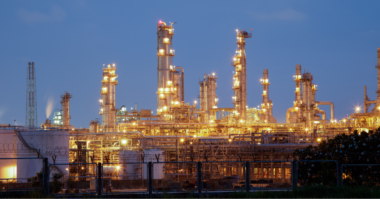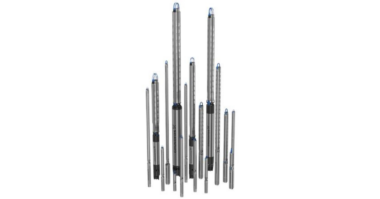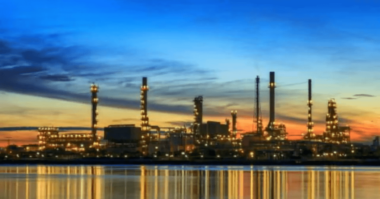Exploration and production of oil and gas is taking place in ever more remote regions of the world and the attention of oil and gas companies in recent years has turned to areas of the globe that are ice bound for much of the year. This poses new challenges for the manufacturers to design equipment that can operate reliably in these hostile environments.
Winterisation is the process of designing oil and gas processing equipment to withstand extreme low temperatures. Winterised pumps will be specified by the contractor or end user on their datasheet to potential suppliers along with the extremity (i.e. the temperature range). Amarinth has been engaged by many global oil and gas companies to provide advice and engineer pumps that can withstand the hostile environment of the sub-arctic ice. Winterising pumps requires careful selection of materials and coatings and design of seal systems, couplings, motors and base plates.
Sub-arctic ice sheets
One such sub-arctic location which Amarinth have recently supplied winterised pumps into is the Prirazlomnoye oilfield located south of Novaya Zemla in northern Russia on the Pechora sea shelf, at a distance of 60km from the shore. This region is subject to extremely low temperatures and strong ice loads. It is ice free for only 110 days a year and the cold period lasts 230 days. The ice thickness is up to 1.7m and the annual average temperature is -4°C with a minimum of -50°C.
The considerations Amarinth made for pumps that can operate reliably in these sub-arctic conditions can be summarised as follows and were all factors considered during the design and manufacture of winterised pumps in the Prirazlomnoye oilfield.
Materials
Stainless steel is usually the minimum choice of material as it is much stronger and less brittle than normal carbon steel in extreme low temperatures. However, other factors such as the pumped fluid have also to be considered though. For example, produced water is often rich is hydrogen sulphide (H2S), which is extremely corrosive and would corrode a stainless steel pump. The best material for this fluid, such as in the Prirazlomnoye oil field, is duplex stainless steel, so there can be conflicts between what is best for the site conditions and what is best for the pumped fluid.
Base-plates
Base plates are usually manufactured from steel, and low carbon steel is suitable down to -25C. However, beyond this point stainless steel should be considered for the base plate as low carbon steel will start to suffer from brittleness. Charpy Impact Testing should be carried out for extreme low temperatures to satisfy brittle tolerances and behaviour under stress and to identify temperature-dependent brittle-ductile transition.
Couplings
Coupling materials can be defined by three common ranges, those being: Standard materials that can operate reliably down to -15C; Low Temperature materials that can operate down to -40C; and Very Low Temperature materials that can operate down to -55C.
In sub-arctic regions such as the Prirazlomnoye field where minimum temperatures can reach -50C, components for couplings have to be selected for Very Low Temperature. Steel variations must be carefully selected, for example, Drive Bolts can be induction hardened and made suitable for higher strength applications when resistance to shock is also required. It is important that in these extreme conditions that the coupling manufacturers work closely with the pump manufacturer to define the operating conditions.
Seals and seal support systems
Seal systems, particular for hazardous fluids such as the produced water being treated by the nutshell filters in the Prirazlomnoye field, must be carefully considered. In addition to the normal winterisation of systems, a number of safeguards should be observed or built into the design to allow the storage and operation of the systems when conditions are as low as -50C.
Low temperature materials and elastomers must be chosen to suit the operating temperatures such as low temperature nitrile bladders for accumulators operating at or below -15C. Standard 316 stainless steel materials within the seal support systems are stronger at low temperatures, however if carbon steel components are used below -20C, impact testing is highly recommended. For cold duties, seal support systems can also be trace heated or lagged. Regardless of the operating protections, the materials have to be able to withstand extreme temperature exposure and be capable of operation once the controlled temperature range is established to be deemed ‘winterised’. The seal support system manufacturer and the pump manufacturer must consider all factors within the design and work together to ensure the complete system meets specifications.
Finishes
Product finish and painting need to be carefully considered. For temperatures as low as -50C, paint finishes could be high solids, low VOC (Volatile Organic Compounds), two pack epoxy abrasion resistant coating which would have low ice adhesion and low frictional resistance. Provided the application is applied and cured at ambient temperature (usually during the manufacture and assembly process) and subject to agreed tests results such as ‘Bresle’ testing (the method used to determine concentration of soluble salts on metal surfaces prior to coating), paint thickness testing, blast cleaning etc., most paint specialists will guarantee the coating effectiveness. The typical film thickness for extreme low temperature needs to be in the region of 400-500 microns (dry).
Motors and drives
Motor manufacturers are usually able to certify their equipment down to -55C. They continue to use and guarantee their grey cast iron housings but the shaft steel will be alloyed heat treated steel specially for cold temperatures, such as 25CrMo4 + QT 1.7218. Specialist grease and shaft seals will be used. Fans need to be made from steel, brass or aluminium, certainly not plastic.
Instrumentation
In the case of instrumentation, they are best mounted within environmental heated enclosures, for example within heated cabinets. Pressure transmitter LCD displays can accommodate temperatures down to -20C, but below this would need to be mounted within heated enclosures. Some pressure gauges can be silicon oil filled allowing them to operate at much lower temperatures than normal and tanks can be lagged or provided with immersion heaters to maintain barrier temperatures.
Heat tracing and lagging of the system and pipework are the most effective solutions for maintaining operation in extreme conditions. Again, material selection and effective use following extreme temperature exposure (capable of full operation once the controlled temperature range is re-established) would be deemed ‘winterised’.
Shipment, storage and installation
There are various storage and preservation procedures recommended to ensure the integrity of the equipment between shipment, storage and installation/start-up. The pump manufacturer must work closely with the contractor and/or end user to ensure storage and installation procedures are detailed to prevent damage to the pumps before operation.
Other considerations
In addition to the winterisation design considerations, in regions such as Russia where such pumps are frequently used, there are further challenges associated with access, passports, language, documentation (GOST-R or GOST-K). Overcoming these additional challenges is also crucial to the overall success of any project and should not be underestimated when selecting a pump manufacturer as the costs for this alone can be significant.
Interestingly API 610 datasheets ask customers to define if they require ‘winterisation’ to the pump by ticking a box. Amarinth has found it difficult to find any industry standard definition of what ‘winterisation’ means and what should be done to achieve this. We have therefore produced this guide which is our interpretation of ‘winterising’ pumps which we hope will be valuable.
For more information, please visit: www.amarinth.com





It was interesting to read more about gas processing in extreme environments such as the sub-arctics. It makes sense that you would have to do so many preparations to prepare for the harsh weathers. All the extra expenses for better materials should end up saving money in the end.